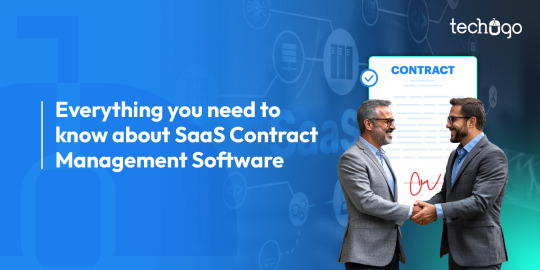#ContractManagementSystem
Explore tagged Tumblr posts
Text
Everything You Need to Know About SaaS Contract Management Software

Learn everything you need to know about SaaS contract management software and how it can streamline your business operations. This innovative solution automates contract creation, approval workflows, and renewal alerts while ensuring compliance and minimizing legal risks. Ideal for companies of all sizes, SaaS-based contract tools offer centralized access, real-time collaboration, and enhanced security. Whether you're handling vendor agreements or client contracts, discover how this software can boost productivity and drive smarter, faster decisions in your contract management process.
#SaaSContractManagementSoftware#B2BSaaSContractManagement#ContractManagementSystem#ContractManagementSoftware#B2BSaaSSoftware#CustomSoftwareDevelopment#facilityManagementSoftware
0 notes
Text
#contractmanagementsystem#contractlifecyclemanagementsoftware#contractmanagementsoftware#contractmanagement#contractmanagementinprocurement#contractlifecyclemanagement#ContractManagementSoftwareOilAndGas
0 notes
Text
Tired of endless paperwork and missed deadlines?
RazorSign is here to transform your work-life balance! Embrace the thrill of efficiency and reclaim your passion for work with our revolutionary CLM software.
Join the revolution - https://www.razorsign.com/solution/contract-management-software.html
#CLMSolution#CLMsoftware#ContractCollaboration#ContractManagementSystem#LegalOperations#ContractTracking
0 notes
Photo

Freight and Truck Rate Contract Management Services company USA
Vee Technologies, a Freight and Truck Rate Contract Management company in the USA, helps you to minimize costs through accurate management of contract information and bills.
Email : [email protected]
Visit : https://bit.ly/3Ix5s9T
#contractmanagement#contractworkflowmanagement#truckcontracts#contractlogistics#contractmanagementsystem#logisticscontractmanagement#contractmanagementsolutions#RateContractManagementcompany#RateContractManagementservicescompanyUSA#USA#VeeTechnologies
0 notes
Photo

The College of Contract Management offers a Professional Practice in FIDIC Contracts to provide you with all the essential knowledge about the types of contracts and their contents through their online courses. You’ll be taught by an industry expert lecturer who will be on hand to help you with any queries.
#ContractManagement#ContractManagementCourses#IACCM#ContractProjectManager#ManagementContracting#ContractManagementSystem#ContractManagementTraining#CommercialContractsManager#FIDIC_Courses#ChangeManagementCourses#ContractManagementCoursesOnline#ContractManagementTrainingCourses#NECContract#ConstructionContractLaw#FIDIC#UnderstandingThe_FIDIC_RedBook
0 notes
Text
Your Project Management Guide for a Complete Contract Migration to a Single Repository
Migrating all your contracts to a single repository is a critical step for your business. Whether you need to merge legacy systems together or you have recently gone through a merger or acquisition, it streamlines how you do business. Many business owners, however, worry that they will face unnecessary downtime and other problems during the migration process. With the appropriate planning, you can protect your business and migrate your contracts to a single, highly effective repository. This will help you meet your contract management goals.
Set Up a Separate Contract Migration Project
Migrating your contracts to a single repository is its own project and should be treated as such. It can be complicated, whether you're migrating several contract repositories at the same time or you're migrating a single existing contract repository to a new system. Set up your contract migration plan as a separate project and treat it accordingly. You may need to: 1. Assess the Scope of the Contract Migration Project Just like when you take a look at a project for a client, you need to take time to assess the scope of your contract migration project. How big of a project are you looking at? How many contracts do you need to move, and how many systems are you bringing together? Take a solid look at what you expect to happen during your contract migration. This includes any potential obstacles that may occur during the contract migration process. Be honest about how long you expect the project to take and just how big a project it is to handle. With this precaution, there’s less risk that you will face unexpected challenges later. 2. Evaluate Your Team Once you have a clear view of the scope of your project, take the time to evaluate your team and their skills. Ask: Who on your team will be responsible for managing the contract migration process? What role will each team member play?Do your team members have the skills needed to help? This includes migrating those contracts, identifying and removing duplicate records, and checking data integrity.What does your team's schedule look like? Do you have time to factor in your contract migration?Do you need to bring in additional help to aid with the contract management process? You may want additional help if your team doesn't have enough time in their schedules to properly handle the project. Also, evaluate the system you're moving to and the challenges it may present, as well as the ability of your team to meet those challenges. Determine what customer service and assistance the contract management system's internal tech team will provide during the migration process. Then, you can get a better idea of what skills your team members may really need to accomplish that migration. 3. Create a Timeline Just like when you put together a project for a client, your team needs to know how long they have to complete the contract migration. Consider: When do you need to have your contract migration completed? You may have a very specific timeline in which to complete your migration. For example, you're using a legacy system that will no longer be supported after a certain date. Alternatively, you might be dealing with a subscription service that you don't want to renew again. You may also find yourself restricted by an upcoming busy season. That means you need to have all your contracts in the new system and everything up and running smoothly. How much time do you have to dedicate to your contract migration project? Your contract migration project will require employees, resources, and time. Look at how those needs fit into your schedule and what you need to do in order to effectively manage your migration and prevent it from interfering with other projects, especially those related to your clients. How long is the project likely to take? Consider factors like both the system you're transferring data to and the system you're transferring data from, since these can put limitations on the speed of your project. Do you need to manually check for data duplication? Do you have automated processes in place that will need to run before the migration is complete? Make sure you have a solid timeline in place that will let you know how long it will probably take to migrate your contracts to the new system.
Design a Plan

Once you have evaluated the full scope of your contract migration and set it up as a project within your system, you need to design a plan that will help keep you on track throughout the migration. Ask: What is the goal of this project? Like any other project, you need to have a clearly defined goal for your contract migration. In this case, it’s to have all of your contracts contained within one contract repository so that you can easily access the information you need when you need it. Secondary goals might include: Ensuring the data is clean and undamaged. You may need to start by creating a data backup as you prepare for your project. Then, you will have clean copies of your contract data to refer back to if something fails to migrate correctly to the new system. Creating a clear organization system that will establish how contracts are stored. You may need an intuitive naming system as well as a storage method that makes sense to every member of the team who must use that system. This is essential if you're migrating over data from different companies. Maintaining security both during and after the migration. You do not want to lose valuable data or leave it vulnerable to hackers, who may choose to use it for their own purposes. Aligning your contract storage system with your company's other goals and plans. Your contract repository can help streamline many of your business practices and make it easier to ensure compliance and full implementation of your contracts. It can also help your company up with billing and other critical financial matters. Setting up workflows and reminders in the new system that will keep business flowing smoothly. Your business needs to flow as smoothly as possible during the transition and afterward. Make sure that your reminders, workflows, and alerts are set up in the new system before you finish the migration. What risks does the contract migration present to the company as a whole? When you migrate your contracts, you may face some risks. As you design a plan to migrate over your contracts, make sure you carefully consider those risks and take steps to mitigate them as much as possible ahead of time. Does your current contract repository pose a known security risk? If you're using legacy systems or outdated contract software, you may find that your existing enterprise contract management system poses a substantial security risk to your business. Migrating to a new, updated system, especially one that already has vital security in place, can help mitigate that risk. Do you have a risk of unexpected downtime during the migration? If you plan to move all your contract data over at once, you may have a period of downtime. You can control this downtime, to some extent, by planning your migration for a time that works best for your company. You may not want to schedule a migration for the busiest part of your day or for a time when you know you can expect increased amounts of business. What resources will you need to accomplish your contract migration? Put together a list of all the resources you will need in order to fully accomplish your contract migration. This includes the time, manpower, and the physical resources you may need to accomplish your migration. Consider: How many people you will need in order to accomplish the migration. Clearly designate which team members you will need to have and what responsibility those team members will need to complete. You may need to block out those team members' schedules during the contract migration. Alternatively, you may need to designate a chunk of time each day to work on migration-related tasks. How long you anticipate the project taking. You already have an estimate of your timeline for contract migration completion. Make sure to include this as part of your plan so that you can schedule the right employees at the right time. What machines you will need to use during the migration. You may want to designate a particular machine or machines to handle the data migration. You may not be able to use this computer for other purposes while you're handling your migration to the cloud. If you currently store your contracts on an in-house server, you may need to dedicate that server to the contract migration process. Make sure to check with your IT team to learn what load those machines can handle and how it will impact the rest of the company. What virtual space you will need to handle the migration. Consider elements like your network security as well as upload speed. Do you want to conduct your contract migration over a separate network from your usual processes? This can help increase upload speed as well as providing you with an additional layer of security, since you can more easily monitor exactly what devices are connected to that network throughout the contract migration process. Are there any additional resources you will need to complete your contract migration project? Consider all the details of your project and what resources you may need to finish it effectively. If you will need to work after hours or on weekends, consider what resources will need to be made available to your team in order to maximize efficiency. Create a clear budget for your contract migration. Make sure you establish what that budget is intended for. Also, leave some room in that budget for overtime if the migration takes longer than intended. How do you plan to set up training?

As part of your contract migration plan, you need to clearly establish how you will handle training the employees who need to know how to use those systems. Many legal contract management systems work in similar ways. But there's always a learning curve when you transition to a new system. Ensure that your employees know how to use all the features built into the system. You have several options when it comes to training. See what training your new enterprise contract management system provider offers. The provider may work directly to train key members of your team or may have a policy that allows you to bring all your employees in for training. In others, the contract management system itself may offer clear alerts and easy-to-use help guides. Make sure you fully understand what the system offers. Train each department all at once. Provide each department with comprehensive training concerning the resources they will use on the contract management system. Train key members of each department, then allow them to train the rest of their departments. If you work in a large company, then you may want to slow that training process down. This can help ensure that everyone has the chance to have their questions answered. Make sure that you schedule training well before you migrate your contracts to the new system. Ideally, your employees should already have a solid understanding of how to use the system when you install it. How do you plan to communicate with team members throughout the project? Communication is a vital part of any major project within your company. You may need to: Clearly establish migration dates.Let employees know how it will impact them.Notify employees about when they are expected to move over to the new system.Provide information about any challenges or problems along the way. You don’t just need to communicate with team members who are directly involved in the migration. You may also need to communicate with employees outside your team who are impacted by the new contract management system. Establish: What system you will use for communication, whether you post information on the company intranet or send out emails or other types of communication. What information employees need to know and when you should schedule reminders.Who is responsible for sending out that information. Contract migration can be a major project. By establishing a clear plan to manage that project ahead of time, however, you can better prepare your business for the process. Ultimately, you’ll set your migration up for success. Try ContraxAware today for a contract management system that fits all of your contracts’ needs. Read the full article
#cnotractmigrationproject#contractmanagementsystem#contractmigration#contractrepository#contractsystem
0 notes
Link
Small business success hinges on optimising client interactions and business procedures. CLM software delivers an environment for productive and systematic contracting processes, resulting in benefits in a number of critical aspects of your small business.
#contractmanagementsoftware#business#software#ContractManagementSystem#contract maintenance software
0 notes
Text
4 Steps You Can Take If No One Can Find a Missing Contract
When it comes time to conduct a contract audit — and the contract is nowhere in sight — most people panic. While this is an understandable feeling, it is preventable and there are solutions. The best step is to catch it before the problem escalates by implementing regular internal contract audit projects. Here are three basic steps you can take when there’s a missing contract:
1. Gather all team members.
If possible, call an emergency meeting to discuss which contract you are specifically searching for. If a team meeting isn't possible, send an email or call those you know worked with the contract. Ask them to remember when they last worked on it and where they remember seeing it last. As you address team members, try to remain calm. Take a deep breath. Then explain the urgency of finding the contract, but don't incite panic. It will only create confusion and chaos as staff scramble to find it. Rally the team, and upon locating the contract, devise a plan to prevent a similar situation in the future.
2. Search paper and digital files.
File cabinets remain a common sight in many offices. So check files and messy desktops for possible paper copies of the contract. If no paper copies are found, ask your IT department to help you conduct a computer search. Check sent email folders to see if the file was emailed to someone internally. And lastly, check the copying machine. Did someone make a copy and leave it in the copier? The case of your missing contract could result in a solution as easy as that. The documents may also be in old archives, email inboxes, and compressed storage drives.
3. Contact the other company for a copy of the missing contract.
This is often the last resort when your internal searches are unsuccessful. Admitting to the other company that you are unable to find a copy of the contract may not leave them with a very good impression. On the other hand, chances are they too have missed place a contract at some point and may ask you for a copy. To remain professional and to prevent embarrassment, consider investing in contract management software for your business.
4. Invest in ContraxAware.

Once you find the missing contract, take steps to ensure one never goes missing again. Investing in contract management software, like that of ContraxAware is your best option for securing and managing contracts in one place. The advanced features of ContraxAware include the ability to: SearchFilterGroup Sort Share As a collaborative tool for your contract management, ContraxAware reduces the risk of losing important contracts. The easy to use dashboard makes it simple for team members to use to find contracts, make changes, alert others to changes, and more. ContraxAware can save you time by eliminating frantic searches for important documents. The time spent searching for a missing contract is a time your business can never recover. It not only upsets the workflow, but it is also a strong indicator that your business needs a better file management system. At ContraxAware, our leaders have software development and legal experience. We understand the issues that can arise when you lose a contract. That's why we developed ContraxAware as a contract management system for business, no matter their size. Your daily work life is stressful enough without the sudden crisis of a missing contract. Streamlining your contract into a centralized system can prevent the unwelcome adrenaline rush of a missing contract. It can also prevent you from having to make an embarrassing call to the other company.
About ContraxAware
At ContraxAware, we've made contract management software simple. From document templates to easy search tools, there's a feature for every member of your team. Special features include restricted access, built-in alerts, and the ability to see updates to contract audit reports. Breathe easier with ContraxAware for your contract management. Our software is 100 percent cloud-based. Also, we provide walkthroughs and online training. Using easy on-screen instructions, you can learn at your own pace, following step-by-step. More advanced subscription plans include one-one internet training. Once you use ContraxAware, you and your team will wonder how you ever lived without it. Contracts are too important for your business to take lightly — or to lose. Such important documents should not float freely around your office in paper form. The risk of landing in the hand of a competitor or a disgruntled employee is too great. Treat all your professional contracts with the same respect you treat your business partners. ContraxAware makes the contract management system process easy and safe. To learn more about how ContraxAware can help your business, contact us online today or call us at (800) 460-9052. No business is too small or too large to implement ContraxAware for their team. So take control of your contract management by reaching out to us today. Ask how you can try ContraxAware for free. Read the full article
#cloudcontractstorage#contractmanagementsystem#contractmanagementtips#digitalcontractstorage#missingcontract
0 notes
Text
5 Reports That Give You Insight Into Your Contract System's Data Integrity
Data integrity is critical to every process in your business, including your contract management software. You want to ensure that the correct data gets shared with your customers and used across your organization. As you move into 2020, you may have committed to improving your business's overall data integrity. Alternatively, that might be a standing goal for your business. If you're migrating over to a new system, ensuring data integrity could be even more critical during that transition. With these key reports, you can test your contract system's data integrity and ensure that you have the right information on hand. We recommend you create them as one step of evaluating your contract management system for 2020. Then schedule automated report generation on a weekly or monthly basis. The top five reports that can help your company improve contract data integrity are:
1. Data Duplication Reports
Your enterprise contract management software may have its own internal data duplication report. If you use a Windows-based server, its Data Deduplication tool can also be used to identify any redundant or duplicate data located within your system and clean it up. When possible, try to manually check data duplication to ensure that you do not mistakenly delete data that you might need in the future. Automated tools, however, can speed up the process and allow you a better glimpse of your system's overall data integrity.
2. Error Checking and Data Integrity Reports
In order to determine the security and integrity of your data collection system, you may need to run an error checking report. These reports may create blank or default data values. Then they check to ensure that the system can retrieve the data without error. You may also want to attempt to retrieve specific values or information from your contract system manually. This ensures that you're able to accurately collect and retrieve the information you need for your daily processes. It’s better to catch errors and bugs early than wait until large sections of data are corrupted.
3. Security Reports

If you find your business suffering a malware attack, check everything. Your data integrity may be compromised, along with other vital parts of your system. Ransomware can lock you out of your data. This is a situation that can be remedied with effective, off-site backups kept separate from your primary data storage. But other types of malware may attempt to steal or overwrite your existing data with new, false data. Your security reports, therefore, are critical for checking over your data integrity. If you notice problems with your organization's security, you may need to perform new scans and tests to validate your contract tracking system's data integrity better.
4. Audit Trails
When your database is running smoothly, you may not think much about it. When you discover a problem, however, an audit trail report can prove invaluable to tracing back the issue to its source. You want enterprise contract management software that will save each copy of a contract or document uploaded to the system. This allows your team to more easily look back over past versions of the document. With these records, you can easily check to see how inaccurate information appeared in the system. Did someone mistakenly duplicate a document instead of saving a new copy as the next step in the process? Did a negotiator put in incorrect terms or fail to include a clause the customer needed in the contract? By creating a clear audit trail, you can more easily determine the source of a problem. You’ll know exactly where in a contract's lifecycle a data error occurred, which means you can more easily fix it. In many cases, you can also prevent it from happening in the future.
5. Backup Files
If your organization is hit with a ransomware attack, suffers a data breach, or loses access to its physical systems, do you have a backup system in place to preserve your data integrity? Ideally, you want well-organized backup files that you can easily access from a location away from your physical office. In the case of a natural disaster, this practice lets you continue to operate even if the disaster interferes with your ability to access the premises. Your enterprise contract management software should also periodically check your backup files for data integrity. If a disaster does occur, then you can easily access current information on your contracts and your clients. Determining the data integrity of your contract management systems, and the rest of your business, takes a substantial amount of time and energy. Fortunately, if you're using a smart contract management system, the system can do it for you! Enterprise contract management software can: Automatically run vital data integrity reports.Email those reports to the individual responsible for checking them or signing off on them.Require essential fields as team members create records.Check fields for data conflicts during record submission. While enterprise contract management software can't solve all your data integrity problems, it can substantially increase the likelihood that you will have the right information at hand at any given time. By choosing the right CLM software, you can set your business up for success when it comes to data integrity. These precautions streamline the process of verifying data. Letting your system automatically review input data also prevents future problems. Learn more about how ContraxAware can help protect your data integrity and your contract records by scheduling a 1:1 demo with our team. Read the full article
0 notes
Text
You Should Completely Reevaluate Your Contract Management System This Often
Your contracts are critical to the overall health of your company: both contracts with your customers and contracts with your vendors. When your legal contract management system is healthy, you'll spend less time dealing with those contracts and more time addressing other critical processes within your business. Equally importantly, you won't miss out on important contract renewal dates that could cost your business both time and money. You know your organization should maintain and regularly reevaluate your contract management system and processes (and our guide here can get you started). But just how often is it necessary?
A General Timeline for When to Reevaluate Your Contract Management System
As a general rule of thumb, you should do an annual audit on the health of your legal contract management system. The beginning of the year, when you're making new resolutions and goals for your business as a whole, is a great time to take care of many of those processes evaluations. Alternatively, schedule it for the middle of the third quarter, when you have time to do a thorough job. Make sure that you: Review your contract templates. You may have made many changes to your business with the beginning of a new year. Your contract templates should change along with it to ensure a more streamlined contract approval process. Check your permissions. Are you maintaining appropriate security for cloud-based or shared systems? Members of your team shouldn’t have access to documents they don’t need. At the same time, good security shouldn’t cause roadblocks. Are all members of the team able to easily access the data they need to handle negotiations, execution, or compliance details? Streamline your processes. Are there are any unnecessary steps in your contract approval process? Do you have the right checks and balances in place to ensure that no problems, including risky contracts or compliance issues, slip through the cracks? Examine your workflow. Check all the processes related to your workflow, from automated emails to reminders. Make sure all of those processes are working smoothly and correctly. Do reminders get sent out on time? Do those emails reflect the information you want sent to your clients or team members, or do you need to make changes to make those more effective? You can also keep up with many of those processes throughout the year. Any time you notice problems with your enterprise contract management software, including reminders that aren't getting sent out on time or user access that doesn't seem quite right, make a few quick changes. Also, prioritize cleanup: if you change your contract terms or need to do away with a particular template, delete it quickly as the year moves forward.
Other Times to Reevaluate Your Contract Management System

An annual review of all of your systems keeps your business strong. But you also want to make sure you're evaluating how you manage contracts online during critical upheavals. You may need to take a closer look at your contract tracking system if: You've recently made big changes to your business. You've just launched a new product or service, hired a new CEO, or made substantial changes to your business's policies. During these busy times, you want to make sure that your legal contract management software is still filling your needs. You may need to adapt permissions, change contract templates, or add in new compliance details. This could impact the way your sales team and your customers interact with those contracts. Don't let those changes fall through the cracks as you continue to shake up the system. Your business has seen extreme growth. If your business has grown more than expected over the course of the year, you may find that your legal contract management systems aren't keeping up as well as you had hoped. Small businesses have processes that work excellently when they’re small. But they can break once you start to grow. If you have a clunky or poorly-organized system, it can be difficult to keep track of all those important contracts. So, you may notice that things start falling through the cracks. Make sure you evaluate your legal contract management system to ensure that it is still meeting your needs. Also, take this time to update any procedures or processes that need to change. You've noticed unexpected problems in the contract life cycle. If you're having problems with your contracts, it does not automatically follow that your enterprise contract management software is to blame. If you're having problems, however, it's a great time to take a look at your system and make sure that it's running smoothly. You may, for example, need to adapt your processes if you notice that the approval timeline is bogging down, or change the wording of an automated email that isn't getting across the point you had hoped. Also, you can add automated emails or specific reminders that will help keep your contracts moving along smoothly. You don't have to live with a problem until it's time for your annual review. Instead, make sure you fix problems before they become more serious. An annual evaluation of your contract system can help keep that system working more smoothly. Not only that, knowing when to reevaluate your contract management system can help prevent problems that could cost your business time or money.
Start the Year Off Right and Reevaluate Your Contract Management System
Like most automated processes, your legal contract management system does need some attention from its users. If you’re bumping into training gaps, don’t just patch the problem. Use these points in the timeline, a careful evaluation could improve efficiency and increase profits. Even after a health check, your systems may no longer keep up with your business. Tired of having to reevaluate your contract management system so often? Try a better system to usher in the new year, and test out ContraxAware with a 7-day free trial. Read the full article
#annualassessment#contractmanagementsoftware#contractmanagementsystem#contractmanagementsystemreview#reevaluateyourcontractmanagementsystem
0 notes
Text
Get a Clear View into Your Contract Management in 2020
With the fresh start of a new year, you may be taking the opportunity to evaluate many of the processes you use in your business on a daily basis — including your contract management. Do you have a clear view of how your contract management system works? What about how you're ensuring that your contracts meet your goals? Also, do you know what problems exist with your contract management software and how to fix them? Try these steps to get a better look at your contract management in 2020 and how it impacts your business.
1. Consider Your Current Requirements
As you evaluate your contract management processes, start by considering your current contract management requirements. If you already have contract management software in place, consider how well you're utilizing it — and if it’s a good fit for the new year. As your business grows and changes, your contract management needs may change along with it. For example, a filing system works fine when you need only handle a few dozen contracts a year. But that will change drastically when you suddenly need to deal with hundreds. Consider your current requirements for contract management as you move into 2020. This is a great time to evaluate the overall health of your contract management system — a process you should undertake regularly. Ask: How many users does your contract management software need to support? As your business grows, your staff grows with it. So you may also need to increase the number of people who can access your contract management solutions. You may also need to change how you grant permissions and access since you may have a more diverse group of people accessing your contracts. Are your current processes for contract management in 2020 working for everyone who uses them? Connect with each department that uses your contract management software, from the sales and negotiation team that puts together your contracts to the team that ensures compliance and execution of the contracts. Take a look at your contract approval process. Make sure that the system works effectively for every member of the team, and consider what changes you might need to make if it doesn't. Once you've taken a hard look at your real needs, you can better determine whether your existing contract management solutions are meeting those needs. You can also see where you may need to make changes as you move into the new year. If you're not sure exactly what you need, consider the criteria for an ideal contract management system and how having that system can help improve your ability to manage your contracts, free up your employees' time, and ensure customer satisfaction.
2. Evaluate Your Contract Management from the Customer's or Vendor's Perspective

Effective contract management solutions don't just work for your company. They also work for your customers and vendors. There are several common problems that many customers have with visibility into specific contract management processes as well as the contract management process as a whole. Take a look at how your customers may view the system. You can even create a false account that will allow you to move through the contract process as a customer, so walk through the whole process. Consider: How long does it take for you to approve contracts on your end? The longer it takes to approve your contracts, the harder it may be on your customers. While you want to be sure that you create rock-solid contracts that cover both your needs and your customers', you also want to streamline the contract approval process as much as possible. An automatic contract scoring process and contract templates can both help streamline the contract approval process, improving overall customer satisfaction with the process. How do customers view the contract? Do you have an effective file-sharing system that will allow customers to view contracts as easily as you can? That may not be enough. It also needs to integrate with the programs that your customers are already using. How do customers interact with the contracts? Many customers prefer to complete as many tasks as they can virtually. It's more convenient, and it allows them to easily share documents or permissions with the correct individuals at their workplace. If your contract management in 2020 doesn't allow for online viewing, storage, and signing of contracts, including requesting alterations when needed, you may be adding steps to the process that frustrate and slow down your customers. Great customer experience is paramount, both when it comes to your customer service and to your contract management processes. By evaluating your contract management needs from your customers' perspective, you can streamline your processes to deliver a better experience for all your customers.
3. Evaluate and Solve Problems with Your Current Contract Management System
It's easy to assume that contract management is something that just happens for your business. You've taken the time to put together the contracts, and the process moves smoothly enough. In order to make your contract management processes more effective and gain more insight into those processes in the coming year, however, take the time to evaluate and solve problems with your contract management system. Consider: Who can access contracts? Ideally, you want a contract management system that allows access to all the individuals who might need access to it, but that closes down access to people who don't need to access contracts at any given moment. A cloud contract management system, for example, may make it easier for all members of your team to access necessary contracts wherever they go. At the same time, you want a secure platform that will allow you to assign user permissions based on the specific role the user fills. Do you have a high level of security in place? The more private customer information you have in your contracts, the more you may need to make sure that you provide a high level of security for all your users. Secure contract management in 2020 can help prevent the theft of customer data, preventing your business from facing costly fines and fees. Without adequate cybersecurity standards, on the other hand, your contract management system could create a number of problems for your business. Are you able to maintain a high level of visibility throughout the contract cycle? Many businesses struggle with contract visibility throughout the cycle. You may not maintain full awareness of your contracts, including important compliance requirements, renewal dates, and more. If you don't have that high level of visibility, it could pose significant problems for your contract execution. Is your team mistakenly using the wrong contracts? Over time, the needs of your business change. You may need to add more details to your contracts because legal requirements in your industry have changed. Alternatively, you might find yourself needing to alter your existing contracts to accommodate changes in customer needs. If you have outdated templates in your contract management system, now is the time to remove or update those contracts to ensure a more successful contract creation and approval process for 2020. Is your current contract management system allowing you to accept an excessive amount of risk? Effective contract management in 2020 should score the risks associated with each of your contracts, preventing you from mistakenly accepting too much risk when you take on a new contract. Whether working with your vendors or your customers, you want to protect your business at every step in the process. Does your contract management system work effectively, with minimal intervention? Technology is a wonderful thing. Cloud-based contract management software makes it easier than ever to keep up with your important contracts and track their implementation. If that technology poses more difficulties than usefulness, however, it can leave you struggling. Choosing a proprietary contract management system — rather than an open-source one — is a solid investment. Proprietary software can go a long way toward helping you combat any problems with your contract management in 2020 by providing access to tech support. Identify potentially invisible problems. In many cases, you may not clearly notice problems with your contract management software or processes. You may assume that everything is moving smoothly. But, in reality, there are small problems that could prevent you from negotiating, approving, and executing contracts as effectively as possible. Identify the potentially invisible problems in your contract management system, including: Contracts that fall through the cracks. Both vendor contracts and customer contracts should remain highly visible. Initiate reminders that let you know when a deadline is approaching or the contract has sat for too long. Then contracts will stop disappearing from your radar.Employees who struggle to use the system effectively. You may have employees who don't know how to use your system or who aren't taking advantage of its features. They’ll substitute with manual steps, which may make you may miss out on important goals and deadlines. Contracts slipping through the approval process with too-high risks. Each year, you need to reevaluate your risk-scoring system to ensure that you don't approve contracts that carry too high a risk for your company.
4. Implement an Effective Training Program

If your employees are going to make the most of your contract management in 2020, they need to know how to use it. Poor user training can turn even the best workflows and software into dead weight. With good training, on the other hand, you can take advantage of all the features offered by your contract management program. You can also make sure that all of your employees can access the data they need. This may include: Allowing your sales team to access contract templates.Letting negotiators know the details that go into scoring your contracts.Providing your employees with access to exactly the information they need. This year: Evaluate what your employees already know. Talk with each team that will take part in your company’s contract management in 2020. Also, consider whether those team members are using it to full advantage. Do they know what features the contract management software offers for each type of contract? Do they know how to effectively utilize your existing software? Start with a full evaluation of how your employees are currently using that software and where they could use improvements. Ask them where they're struggling. If you do not have a staff member who can answer those questions, contact technical support to ask. Institute regular training. If you notice that your employees are struggling to use the software and workflows that back you contract management in 2020, catch it early. Institute a training program that will help give them a better idea of all its features and how it works. An employee who understands the basics might need more assistance, for example, to better understand effective contract scoring. You may also want to design a training program or protocol for new employees or for employees who move into new positions.
5. Check for Any Holdups in Your System
If your internal processes aren't in line with what it offers, that’s a problem. You can bog down your contract management processes and make it difficult to get contracts approved and executed effectively. Evaluate potential snags and holdups in your contract management in 2020. For example, are you: Requiring too many people to approve each contract as it moves through your system?Allowing a contract to sit for too long before moving forward in the system?Tracking your contracts as they move through the system? Then, you’ll always know what stage they're in and what is needed next.Using processes that move the contract from the negotiation phase to the execution phase smoothly? If you identify potential bottlenecks that could prevent contracts from moving smoothly through your system, 2020 is an excellent time to change your processes. Review your contact management system now to help move contracts through faster all year long. Ultimately, this can increase your revenue and decrease your overall costs. Your contract management system is an important part of maintaining your business. This year, make sure you handle it more effectively and have a higher level of visibility into your business by following these key steps. Contact us to learn more about our contract management solutions and how they may improve contract management processes for your business. Also, you can try out our software with a 7-day free trial. Read the full article
#contractmanagementin2020#contractmanagementsoftware#contractmanagementsystem#processimprovements#reviewyourcontractmanagementsystem
0 notes
Text
Five Contract Management KPIs That Your Business Team Needs to Agree On
Short-term wins do not necessarily translate to long-term growth for your business. When you want to be competitive for the long haul, attention to detail is essential. You need to measure the different growth aspects of your business and identify areas that need changing and any improvements you might need to make. Ideally, measuring the specific KPIs for the performance of your business is a great way to achieve this. In a nutshell, Key Performance Indicators are a set of quantifiable measurements that gauge the long-term performance of your business, and you can dive deep into identifying and measuring core KPIs with our guide. When used in the right way, they can offer decision-making insights to C-level executives and departmental leaders. They can also provide insights on the different changes that need to be made to contracts to ensure you are optimizing them for long-term growth. But some of the most valuable KPIs aren’t metrics that you can decide for yourself. Your CFO needs to set the threshold for acceptable discounts. Your CIO has to be part of the conversation when you’re setting Service Level Agreements for online services. So bring up these KPIs at the next executive meeting to get concrete answers:
1. Internal Process Quality
The quality of your internal processes is tied to a variety of factors of your business, including: Customer satisfaction ratesEmployee safetyYour business’s reputation Ideally, the more efficient your internal processes are, the easier it will be to develop a competitive edge in your industry. In turn, this can earn you more customers and contracts since you will be an inviting business to work with. Quality processes can include the quality of how you handle invoices, how you store data, the manufacturing process, and even customer service. The same bottlenecks holding up your contract management may be impacting your whole business. You need to create KPIs that will identify all these aspects and have individuals monitoring the progress of every KPI that impacts their particular department.
2. Average Spend per Sale
How much does each sale cost you on average? Remember, the more sales you make, the higher your revenue, owing to the economies of scale. But that doesn’t guarantee profitability. Ideally, you ought to ensure that everything you spend towards the fulfillment of a sale is optimized. Customers need to feel the value of your product offering. Calculate and continue to monitor your CAC, or customer acquisition cost, to stay on target. Measuring this KPI and working with your CMO will help you understand customer purchasing behavior. You can set a specific average spend per sale, and make product tweaks in anticipation of any changes. This will make it easy to measure the success rate of product promotions, upselling efforts, and even customer loyalty campaigns. When it comes to contracts, it can provide you with insights that will help you create deals that provide the most value per sale.
3. Working Capital

Sometimes, big business opportunities might show up when you might not have the funds to channel into them. For example, a big client might want to get into a contract with you, but the fact that a previous client hasn't yet settled their invoices makes it tough to start this new contract. The best way forward might be to get a loan from a bank or investor as you wait for the invoice to be settled. However, if you aren't tracking your current level of working capital, you can get surprised when a major opportunity knocks on your door. Tracking working capital will offer you insights on how to spare some cash to use in these types of situations. Also, it can help you identify whenever it is critical to push clients to settle overdue invoices.
4. Effectiveness of Income Sources
In case you have a variety of income sources, you need to understand what sources bring in the most profit. This can be advantageous in two ways: In determining the most profitable parts of your business. For instance, a marketing agency might identify that it earns more revenue from content writing than from Facebook ads.In making informed decisions that can help grow your revenue sources. For instance, the same marketing business can choose to focus more resources on content marketing as well as look for strategies that make Facebook ads more profitable. Monitoring this mix of income sources can help you create a portfolio that will propel your business's growth. It also becomes easy to identify any setbacks. For income sources that are only draining your resources, you can easily get rid of them.
5. Revenue Concentration
While this is closely related to income source KPIs, it can help you keep your business afloat. The goal is to ensure that you have diverse sources of income. In case the bulk of your revenue is coming from one or two clients, you risk going under if you lose the clients. This can also apply for suppliers — more suppliers translate to fewer risks of failed deliveries. To calculate the basic income percentage of each client, you need to divide the income gained from each client by the total revenue and multiply it by 100. It is wise to look for other clients if it appears that one client is making the most contribution to your monthly income. Big core clients are important sources of revenue, but it pays to have other small income sources to protect your business. KPIs will offer you enough attention to detail to identify the changes you need to make for your business. They not only give you insights into the top-performing parts of your business, but they also help you remain afloat during tough times. Concentrate on measuring KPIs to rely on educated insights for business growth. You may have noticed that a lot of these KPIs center around the money that the contracts represent. So make sure you have a solid relationship with your company’s finance team — as well as the sales teams — to make sure you’re all on the same page for scoring your contracts. If you already have strong KPIs in mind, sign up for a trial of our contract management software to put them into action. Read the full article
#businessteamplanning#contractmanagementhelp#contractmanagementplanning#contractmanagementsoftware#contractmanagementsystem#KPI&039;s#longtermbusinessgrowth
0 notes
Text
Five Contract Management KPIs That Your Business Team Needs to Agree On

Short-term wins do not necessarily translate to long-term growth for your business. When you want to be competitive for the long haul, attention to detail is essential. You need to measure the different growth aspects of your business and identify areas that need changing and any improvements you might need to make. Ideally, measuring the specific KPIs for the performance of your business is a great way to achieve this. In a nutshell, Key Performance Indicators are a set of quantifiable measurements that gauge the long-term performance of your business, and you can dive deep into identifying and measuring core KPIs with our guide. When used in the right way, they can offer decision-making insights to C-level executives and departmental leaders. They can also provide insights on the different changes that need to be made to contracts to ensure you are optimizing them for long-term growth. But some of the most valuable KPIs aren’t metrics that you can decide for yourself. Your CFO needs to set the threshold for acceptable discounts. Your CIO has to be part of the conversation when you’re setting Service Level Agreements for online services. So bring up these KPIs at the next executive meeting to get concrete answers:
1. Internal Process Quality
The quality of your internal processes is tied to a variety of factors of your business, including: Customer satisfaction ratesEmployee safetyYour business’s reputation Ideally, the more efficient your internal processes are, the easier it will be to develop a competitive edge in your industry. In turn, this can earn you more customers and contracts since you will be an inviting business to work with. Quality processes can include the quality of how you handle invoices, how you store data, the manufacturing process, and even customer service. The same bottlenecks holding up your contract management may be impacting your whole business. You need to create KPIs that will identify all these aspects and have individuals monitoring the progress of every KPI that impacts their particular department.
2. Average Spend per Sale
How much does each sale cost you on average? Remember, the more sales you make, the higher your revenue, owing to the economies of scale. But that doesn’t guarantee profitability. Ideally, you ought to ensure that everything you spend towards the fulfillment of a sale is optimized. Customers need to feel the value of your product offering. Calculate and continue to monitor your CAC, or customer acquisition cost, to stay on target. Measuring this KPI and working with your CMO will help you understand customer purchasing behavior. You can set a specific average spend per sale, and make product tweaks in anticipation of any changes. This will make it easy to measure the success rate of product promotions, upselling efforts, and even customer loyalty campaigns. When it comes to contracts, it can provide you with insights that will help you create deals that provide the most value per sale.
3. Working Capital

Sometimes, big business opportunities might show up when you might not have the funds to channel into them. For example, a big client might want to get into a contract with you, but the fact that a previous client hasn't yet settled their invoices makes it tough to start this new contract. The best way forward might be to get a loan from a bank or investor as you wait for the invoice to be settled. However, if you aren't tracking your current level of working capital, you can get surprised when a major opportunity knocks on your door. Tracking working capital will offer you insights on how to spare some cash to use in these types of situations. Also, it can help you identify whenever it is critical to push clients to settle overdue invoices.
4. Effectiveness of Income Sources
In case you have a variety of income sources, you need to understand what sources bring in the most profit. This can be advantageous in two ways: In determining the most profitable parts of your business. For instance, a marketing agency might identify that it earns more revenue from content writing than from Facebook ads.In making informed decisions that can help grow your revenue sources. For instance, the same marketing business can choose to focus more resources on content marketing as well as look for strategies that make Facebook ads more profitable. Monitoring this mix of income sources can help you create a portfolio that will propel your business's growth. It also becomes easy to identify any setbacks. For income sources that are only draining your resources, you can easily get rid of them.
5. Revenue Concentration
While this is closely related to income source KPIs, it can help you keep your business afloat. The goal is to ensure that you have diverse sources of income. In case the bulk of your revenue is coming from one or two clients, you risk going under if you lose the clients. This can also apply for suppliers — more suppliers translate to fewer risks of failed deliveries. To calculate the basic income percentage of each client, you need to divide the income gained from each client by the total revenue and multiply it by 100. It is wise to look for other clients if it appears that one client is making the most contribution to your monthly income. Big core clients are important sources of revenue, but it pays to have other small income sources to protect your business. KPIs will offer you enough attention to detail to identify the changes you need to make for your business. They not only give you insights into the top-performing parts of your business, but they also help you remain afloat during tough times. Concentrate on measuring KPIs to rely on educated insights for business growth. You may have noticed that a lot of these KPIs center around the money that the contracts represent. So make sure you have a solid relationship with your company’s finance team — as well as the sales teams — to make sure you’re all on the same page for scoring your contracts. If you already have strong KPIs in mind, sign up for a trial of our contract management software to put them into action. Read the full article
#businessteamplanning#contractmanagementhelp#contractmanagementplanning#contractmanagementsoftware#contractmanagementsystem#KPI's#longtermbusinessgrowth
0 notes
Link
To keep your organization competitive in the contract management sphere, we have developed a list of contract management tools most conducive to enhance contract results and productivity.
Contract management tools like contract lifecycle management products are at the heart of any contracting process. With the help of five crucial tools, Dock 365 makes sure your company has a comprehensive, automated and secure way to create and manage compliant contracts.
0 notes
Link
Artificial intelligence in contract management is intended to free up contract professionals' time to strategize and make educated decisions based on a better understanding of contract risk and the positive and negative linkages between data, contract language, and contract processes.
With automated data input and risk assessment mapping, it is designed to expedite data insertion, data extraction, data security measures, and risk identification tasks. Contract management software powered by artificial intelligence (AI) transforms static contract documents and data into dynamic building blocks that contract managers require for better contract oversight, proactive opportunity identification, and risk reduction.
Dock 365 has implemented AI technology to provide you with the most sophisticated contract management software capabilities to meet your specific aims and business requirements. Our solution integrates seamlessly with your Microsoft 365 environment, utilising Teams and SharePoint for improved communication and collaboration across all of your contracts.
0 notes
Text
How to Manage Your Contract Pipeline with Remote Access
Making the shift to remote contract management is a big step for your business. It’s one that many businesses have had to make quickly in the light of the COVID-19 pandemic. Properly managing your contract pipeline is critical to keeping your business flowing smoothly during this period. You want to make sure your contracts move smoothly down the contract pipeline with remote access features. A smarter contract management system can help, often without the in-person touches that usually help your business manage those tasks. To manage your contract pipeline with remote access, try some of these important steps.
1. Make sure all employees have the right access.
When you're in the office, things are simpler. An employee who doesn't have access to the right contract documentation can simply walk down the hallway and find someone who does. Unfortunately, when your employees are working remotely, they might not have access to others who can get them into those documents. As you prepare your contract pipeline for remote access, make sure your employees have the right access. Make sure logins are current, that all employees know their passwords, and that they can access contract data remotely. This is also a great time to remove old logins for employees who have left the company.
2. Create contract processes that include automated checks and reminders.

When working remotely, it's important to include automated reminders for your employees. This can help ensure that they take care of all of their obligations with regards to your contracts in a timely, effective manner. Your employees are out of their familiar element. They’re away from the office and struggling to adapt to new and changing circumstances. Make sure your contract management software offers the reminders they need: Reminders That Action Needs to Be Taken on a Contract Has a contract been allowed to sit too long in a particular queue or at a particular stage of the approval process? Make sure you issue a reminder that will let your employees know that action needs to be taken. Contract Scoring Automatic contract scoring can help you identify any potential challenges with a contract before it moves further through the approval process. Remote work can mean longer approval times and fewer connections between members of your team. This can make it easier for potential errors to fall through the cracks. With automated contract scoring, on the other hand, you'll be able to more easily identify any potential challenges with the contract before they become more serious. Renewal Reminders Do you have contracts coming up for renewal during this period of remote work? Make sure employees get reminders well ahead of time so that they can begin negotiations. This can ensure they will have time to take into account current events and how they may impact future contracts with a given partner.
3. Automatically move your contracts on to the next phase in the contract cycle.
Once a specific stage of the contract process has been completed, it needs to move on. Set up your contract management system to automatically send the contract on to the next stage in the process. You may, for example, need to move it straight from the sales team to approval. Alternatively, a smart system can move it through the stages of approval. Make sure it automatically moves to the next person who needs to see it. Then your team can accomplish their tasks remotely and easily.
4. Make sure you have a remote signature option in place.
Connect your contract management software with a remote signature platform. This will allow both your team and your contractual partners to sign your contracts without having to be in the same place. These e-signatures are just as binding as physical signatures on a document. But they don't require team members to leave the safety of their homes or expose themselves to potential infections. A contract pipeline with remote access to e-signature options will also ensure that the signed version of the contract is stored online, where your team can easily access it.
5. Institute virtual contract compliance monitoring.
Contract compliance — both with external regulations and with the terms of the contract — is incredibly important to your business. You want your contractual partners to know that you will continue to meet your obligations even during a difficult period. Make sure you have virtual contract monitoring in place that will allow you to keep up with how well your employees are complying with the terms of the contract. You should also monitor whether vendors are keeping up with the terms of your current contracts and whether you need to make changes to any of your contracts based on the current situation. Shifting to a contract pipeline with remote access features can offer unique challenges. With these strategies, however, you can move your contract smoothly down the pipeline and ensure that your business has everything it needs to continue to thrive and meet its obligations during this time. See how ContraxAware can help by scheduling a 1:1 demo. Read the full article
#automatingcontract#contractmanagementsystems#contractpipeline#improvingcontractmanagementworkflow#remotework
0 notes